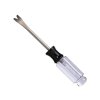JimT
Enthusiastic about Wooden Canoes
I appreciate the insights of both approaches to the sponson canvassing challenge. I've got Thurlow's book and had already looked over his description of the task. If I'm not mistaken Dave Osborn shared pictures of his approach earlier in this thread, seems like he uses a strategy closer to what Michael suggests? but maybe he will chime in here also, I'm going by this photo:

At any rate that will be a bit down the road. Spent yesterday soaking down screw heads with paint stripper (some of the last methyl chloride stripper I could find in town, guess that's going the way of five cent coca cola in another month or so) and removed the seats so I could get at the ribs and floor underneath them for scraping. And thank goodness for hollow ground screw drivers, there's not a matching screw yet. So far I'm only seeing a small handful of cracked ribs, spent some time last night reading up on backside rib repairs as an alternative to replacing ribs. I'll share some photos when I get closer to that stage of the work.
I'm a little nervous about getting the fiberglass residue off the planking. I was able to strip, scrape, and then sand the residue off of a section of the transom--but that's a much more substantial piece of wood then the planking. Any advice on cleaning up the exterior of the hull would be appreciated.

At any rate that will be a bit down the road. Spent yesterday soaking down screw heads with paint stripper (some of the last methyl chloride stripper I could find in town, guess that's going the way of five cent coca cola in another month or so) and removed the seats so I could get at the ribs and floor underneath them for scraping. And thank goodness for hollow ground screw drivers, there's not a matching screw yet. So far I'm only seeing a small handful of cracked ribs, spent some time last night reading up on backside rib repairs as an alternative to replacing ribs. I'll share some photos when I get closer to that stage of the work.
I'm a little nervous about getting the fiberglass residue off the planking. I was able to strip, scrape, and then sand the residue off of a section of the transom--but that's a much more substantial piece of wood then the planking. Any advice on cleaning up the exterior of the hull would be appreciated.





















